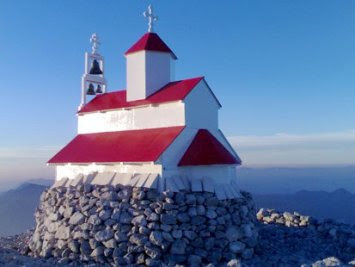
Rumija is a mountain in South Montenegro. The highest point of Rumija Mountain is Rumija, which is 1,594 m (5,230 ft) high.
Rumija rises above the town of Bar, and is a natural Dinaric barrier, separating Adriatic Sea from Skadar Lake basin.
The Rumija Mountain is a site of great religious significance. The Cross of Jovan Vladimir is carried every year on the Feast of Pentecost from the village of Velji Mikulići to the summit of Rumija. Traditionally, in addition to Orthodox Christians of Bar area, Catholics and Muslims also take part in the procession and ascent to Rumija summit.
In 2005, Serbian Orthodox Church mounted a metal church building to the summit, by means of Air Force of Serbia and Montenegro helicopter. This was a highly controversial issue, as building of the church was not approved by Montenegrin authorities. The use of the Air Force helicopter was perceived by some as a provocation in the wake of Montenegrin independence referendum. As of 2011, the church is still standing.
Source
Cross of Vladimir
The cross, which by tradition is the one that Jovan Vladimir held in his hands when he was martyred, is a highly valued relic. For centuries, it has been under the care of the Andrović family from the village Velji Mikulići near Bar. According to the Androvićs, a man whom they describe as a priest or a nobleman was the first who had kept the cross with the pledge that he and his descendants would preserve it. The Androvićs acquired it when a daughter of that man's last male descendant married one of them, and brought the cross as a part of her dowry. They have kept it as the greatest value, protecting it with their lives. Its location has always been known only to two oldest male members of the family.
According to a research by Russian historian Ivan Yastrebov, after Vladimir's death Kosara brought the cross from Prespa to Krajina. It was kept with other relics at the Monastery of the Most Holy Theotokos. At the peak of Islamization of this region in the 18th century, the monastery was torn down, and the cross was given to the people of Krajina. They regarded it as a protector of the clan and a symbol of rich harvest, and kept it as a great sanctity, although they converted to Islam. Yastrebov concludes that the cross was taken from them by the neighboring Mrkojevići clan, who then ceded it to the Androvićs. The cross, made of yew wood, was plated with silver at the end of the 16th century. A brass ball was fixed at its bottom, into which a stick is inserted when the cross is carried. It is 45 cm high, 38 cm wide, and 2.5 cm thick.
The cross, followed by a religious procession, is carried every year on the Feast of Pentecost from Velji Mikulići to the summit of Mount Rumija. All the participants in this celebration gather at Velji Mikulići the day before. The procession is preceded by a liturgy in the village's Church of Saint Nicholas, which begins at midnight. After the liturgy, at about one o'clock a.m., the ascent begins up a steep path to the 1593-meter-high summit of Rumija. At the head of the procession is the cross, carried by a member of the Andrović family, a priest goes behind him, and then follow the other participants. Among the guests are also Catholics and Muslims of the region. It is carefully observed that no one comes ahead of the cross; doing that is considered a bad omen. The ascending devotees sing:
Krste nosim,
Boga molim,
Gospodi pomiluj.
I carry the cross,
I pray to God,
Lord, have mercy.
A tradition has it that a church dedicated to the Holy Trinity stood at the summit, built by Jovan Vladimir, and razed by Ottomans. There was, therefore, a custom to pick up a stone at a certain distance from the peak, and carry it to that destination. It was believed, when a sufficient quantity of stones were collected, the church would rebuild itself. A church building dedicated to the Holy Trinity stands there again since 2005, erected and consecrated by the Serbian Orthodox Church. The procession arrives at the mountain peak before dawn, and at sunrise the morning liturgy begins. After the prayers are offered at the summit, the procession goes back to Velji Mikulići, again following the cross. On the way back, some people pick a medicinal plant called the red root of Rumija. The procession ends at the Church of Saint Nicholas, and folk festivities in Velji Mikulići continue until late at night.
From century to century, the Cross of Vladimir has bathed in the sun's rays at the peak of Rumija on every Feast of Pentecost, excepting the period from 1959 to 1984, when the celebration was not held. Its course was somewhat changed during the 1999 bombings: for security reasons, the cross was not carried up to the summit, and it was shown, for the first time, during the midnight liturgy in the Church of Saint Nicholas. That has been a curiosity, because people normally cannot see the cross before the start of the procession.
Source
Read also: Serbia and Montenegro: The Politics Of Churches And Helicopters
See a more complete video here.